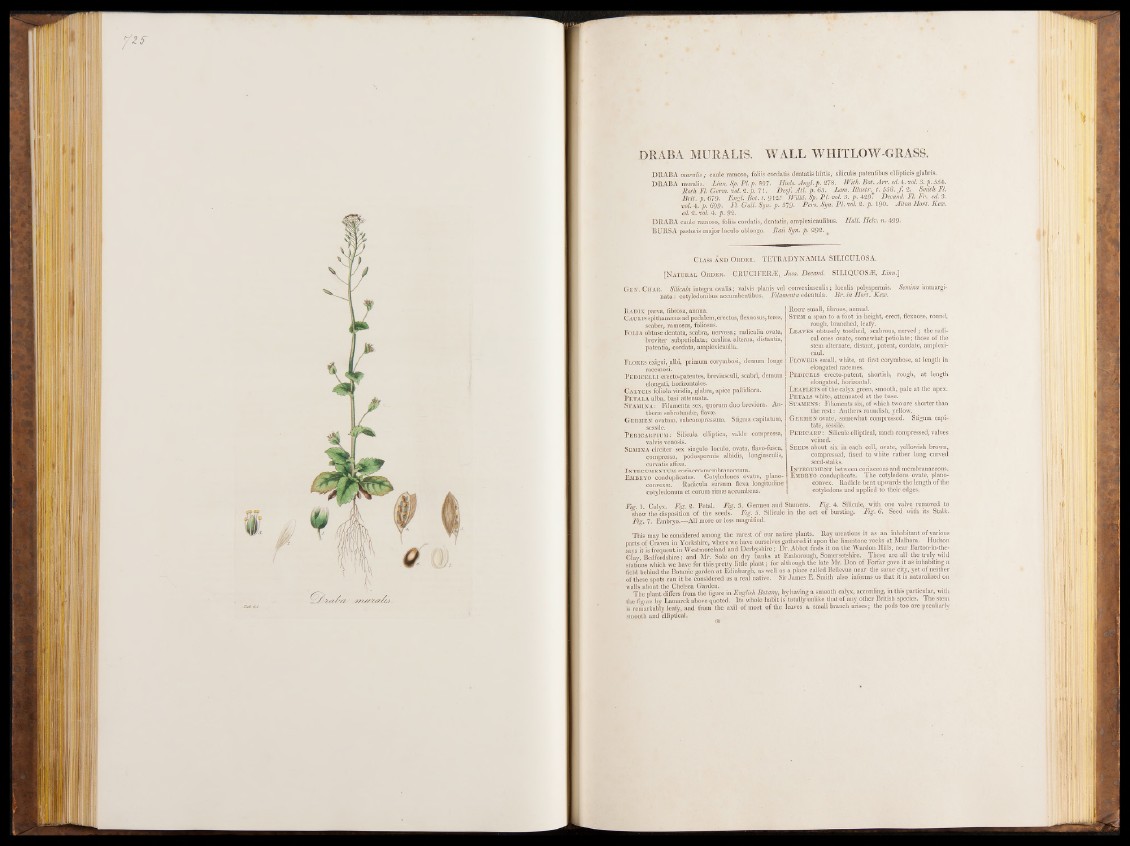
DRABA MURALIS. WALL WHITLOW-GRASS.
DRABA muralis; caule ramoso, foliiscordatis dentatis hirtis, siliculis patentibus ellipticis glabris.
DRABA mural is. Linn. Sp. PI. p. S97. H u is. Attgl. p . 278. With. Bot. A rr. ei. 4. vol. 3. p. 554.
R oth FI. Germ. vol. 2. p. 71. Derf. A ll. p. 65. Lam. Illustr. t. 556. f . 2. Smith Fl.
B r it. p. 679. Eugl. Bot. t. 912? W illi. Sp. PI. ml. 3. p . « 9 . Decani. Fl. Fr. cd. 3.
ml. 4. p. 699.. Fl. Gall. Spn. p. 379. P e n .S y n . P I. ml. 2. p, 190. Alton H ort. Kao.
' ed. 2. vol. 4. p. 92.
DRABA caule ramoso, foliis cordatis, dentatis, amplexicaulibus. Hall. Helv. n. 499•
"BURSA pastoris major loculo oblonge. Rail Syn. p. 292. #
C lass and Ord e r . TETRADYNAMIA SILICULOSA.
[N atural Ord e r . CRUCIFERÆ, Juss. Decand. S IL IQUOSÆ, Linn.\
Ge n . Ch a r . Silicula integra ovalis ; valvis planis vel cónvexiusculis ; loculis polyspermis. Semina immargi*
n ata: cotyledonibus accumbentibus. Filament a edentula. B i \ in Hort. Kew.
R adix parva, fibrosa, annua.
Caulis spithamæus ad pedalem,erectus, flexuosus, teres, ;
scaber, ramosus, foliosus.
Folia obtuse dentata, scabra, nervosa; radicalia ovata,
breviter subpetiölata; caulina alterna, distantia,
patëntia, cordata, amplexicaulia.
F lores exigui, albi, primum corymbosi, demum longe
racemosi.
P ed ic e l l i erecto-patentes, breviusculi, scabri, demum
elongati, horizontales.
Càlycis folibla viridia, glabra, apice pallidiora.
P etala alba, basi attenuata.
Stamina : Filamenta sex, quorum duo breviora. An-
theræ siibrotundæ, flavæ.
G e r h e n ovatum, Subcompressum. Stigma capitatum,
t sessile.
P e r ica r p ium : Silicula elliptica, valde compressa,
valvis venosis.
Semina circiter sex singulo loculo, ovata, flavo-fusca,
compressa, podospermis albidis, longiusculis,
curvatis affixa.
INTEGUMENTUM coriacéo-membranaceum.
E mbryo conduplicatus. Cotyledones ovatæ, plano-
convexæ. Radicula sursum flexa longitudine
cotyledonum e t ebrum rimæ accumbens.
Root small, fibrous, annual.
Stem a span to a foot in height, erect, flexuose, round,
rough, branched, leafy.
Leaves obtusely toothed, scabrous, nerved; the radical
ones ovate, somewhat petiolate; those of the
stem alternate, distant, patent, cordate, amplexi-
caul.
F lowers small, white, a t first corymbose, a t length in
elongated racemes.
P edice l s erecto-patent, shortish, rough, at length
elongated, horizontal.
Leaflets of thé calyx green, smooth, pale a t the apex.
P etals white, attenuated at the base.
Stamen s: Filaments six, of which two are shorter than
the r e s t: Anthers roundish, yellow.
Ge rm en ovate, somewhat compressed. Stigma capitate,
sessile.
P e r ica r p : Silicule elliptical, much compressed, valves
veined. •
Seeds about six in each cell, ovate, yellowish brown,
compressed, fixed to white rather long curved
seed-stalks.
I n tegument between coriaceous and membranaceous.
E mbryo conduplicate. The cotyledons ovate, planoconvex.
Radicle bent upwards the length o f the
cotyledons and applied to their edges.
Fig. 1. Calyx. Fi*. 2. Petal. Fig. 3. Germen and Stamens. Fig. 4. Silicule, with one valve removed to
show the disposition of the seeds. Fig. 5. Silicule in the act of bursting. Fig. 6. Seed with its Stalk.
Fig. 7. Embryo.—All more or leas magnified.
This may be considered among the rarest of our native plants. Ray mentions it as an inhabitant of various
parts of Craven in Yorkshire, where we have ourselves gathered it upon the limestone rocks at Malham. Hudson
says it is frequent in Westmoreland and Derbyshire; Dr. Abbot finds it on the Wardon Hills, near Barton-in-the-
Clay Bedfordshire ■ and Mr. Sole on dry banks at Emborough, Somersetshire. These are all the truly wild
stations which we have for this pretty little plant; for although the late Mr. Don of Forfar gave i t as inhabiting a
field behind the Botanic garden at Edinburgh, as well as a place called Bellevue near the same city, yet of neither
of these spots can it be considered as a real native. Sir James E. Smith also informs us that it is naturalized on
walls about the Chelsea Garden. . . . . ,
The plant differs from the figure in English Botany, by having a smooth calyx, according, m this particular, with
the figure by Lamarck above quoted. Its whole habit is totally unlike that of any other British species. The stem
is remarkably leafy, and from the axil of most of the leaves a small branch arises; the pods too are peculiarly
smooth and elliptical.